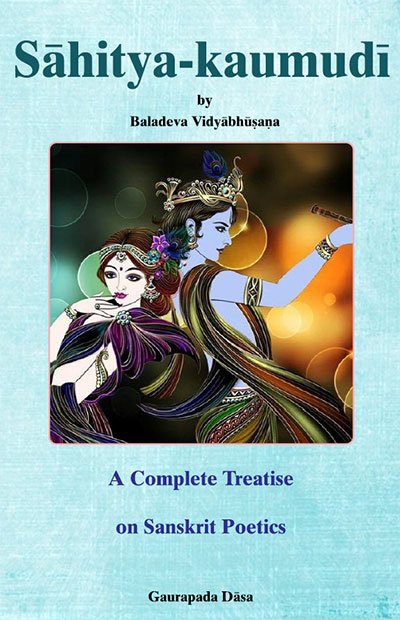Sahitya-kaumudi by Baladeva Vidyabhushana
by Gaurapada Dāsa | 2015 | 234,703 words
Baladeva Vidyabhusana’s Sahitya-kaumudi covers all aspects of poetical theory except the topic of dramaturgy. All the definitions of poetical concepts are taken from Mammata’s Kavya-prakasha, the most authoritative work on Sanskrit poetical rhetoric. Baladeva Vidyabhushana added the eleventh chapter, where he expounds additional ornaments from Visv...
Text 10.115
अनायास-कृशं मध्यम् अशङ्का-तरले दृशौ ।
अभूषण-मनोहारि वपुर् वयसि सुभ्रुवः ॥
anāyāsa-kṛśaṃ madhyam aśaṅkā-tarale[1] dṛśau |
abhūṣaṇa-manohāri vapur vayasi subhruvaḥ ||
anāyāsa—without exertion; kṛśam—thin; madhyam—the waist; aśaṅka—without fear; tarale—fickle; dṛśau—the two eyes; abhūṣaṇa—without ornaments; manohāri—charming; vapuḥ—the body; vayasi—in the age (youth); su-bhruvaḥ—of the woman with beautiful brows.
In youth, the waist of a woman with beautiful brows is thin even in the absence of exercise, her eyes are fickle though she is not afraid, and her body is charming even without ornaments. (Sāhitya-darpaṇa 10.66)
atra vayo nimittam uktam. atraiva vapur dīvyati subhruvaḥ iti pāṭhe tv anuktaṃ tat.
Here the reason, youth, is stated. By replacing the word vayasi (in youth) with dīvyati (is resplendent), the variety where the reason is not stated takes place.
Commentary:
This is Mammaṭa’s example:
kusumita-latābhir ahatāpy adhatta rujam ali-kulair adaṣṭāpi |
parivartate sma nalinī laharībhir alolitāpy aghūrṇata sā ||“That lotus felt pain though it was not struck by a blossoming creeper, turned around though it was not stung by bees, and floundered though it was not swerved by waves” (Kāvya-prakāśa verse 473).
According to Nāgeśa Bhaṭṭa, the representation of the heroine, who is feeling the pang of separation, as a lotus is a metaphor (and not an atiśayokti), because of the addition of the pronoun sā (that).[2] In this verse the cause, separation from her beloved, is not stated.
Footnotes and references:
[2]:
sā nālinīti rūpakam (Uddyota).
